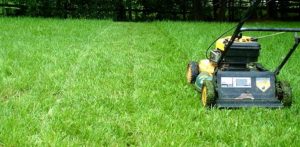Summer heat can take a toll on turf, especially when your lawn care program falls short. If you mow too low, water too much or too little, or ignore early signs of pests, your grass could quickly become lackluster or even completely die in small or large patches.
Keep your lawn looking its best all summer long by mastering these Top 10 summer lawn care tips.

1. Mow at the right height.
In summer, adjust your mower height to leave grass taller. Taller grass shades soil, which reduces water evaporation, leads to deeper roots and prevents weed seeds from germinating. Ideal mowing height varies with grass type. Time mowings so you’re never removing more than one-third of the leaf surface at a time.
2. Water properly.
For the healthiest grass, water your lawn deeply and infrequently. Check with your local water authority or Cooperative Extension office for recommended irrigation schedules. Discover tips on how much water a lawn needs. Learn the basics of lawn watering.
3. Treat for grubs.
Japanese beetles, June bugs (beetles) and European chafers lay eggs in grass in early to midsummer. Eggs hatch into grubs in mid- to late summer. Timing varies by beetle and region. Check with your local Cooperative Extension office to determine the best time to put down grub control.
4. Clean up after your pooch.
The family dog can cause dead spots on a lawn. If you see dying grass due to your dog’s urination, flush the area with water to dilute the urine in soil. The best solution is to create a mulched or pebbled area and train your dog to use that area for bathroom breaks. Also, keep waste picked up and dispose of it properly.
5. Avoid parking on the grass.
Driving or parking on the lawn is never a good idea. It leads to soil compaction, which can cause a host of other problems, including dead grass. During drought or times of excessive heat, it’s even wise to limit foot traffic on grass to avoid damaging turf crowns.
6. Sharpen your mower blade.
A dull mower blade tears grass, creating ragged, brown edges that provide an opening for disease organisms. Sharpen your mower blade regularly. The rule of thumb is that a sharp blade lasts for 10 hours of mowing. Consider purchasing a second blade so you’ll always have a sharp blade at the ready.
7. Let clippings lie.
If you’re mowing grass at the right height, you can let clippings lie on the lawn. This practice is called grasscycling and saves you time, money and fertilizer.
8. Fertilize warm-season grasses.
Warm-season turf grows strongly during summer and needs nutrients. Check with your local cooperative extension office to learn fertilizer schedules for your region. Do not fertilize cool-season lawns during summer. Wait until fall or early spring.
9. Pick up litter.
Summer activities can result in toys, water games, lawn chairs or tools being left on turf. Avoid harming – or even killing – turf crowns by putting away gear after use.
10. Tackle weeds.
Deal with weeds as they appear throughout the growing season. Apply weed control in late summer/early fall to help deal with cool-season weeds, especially if you tend turf in cooler regions and have an established dandelion or perennial weed problem. Do not apply a pre-emergent herbicide in fall if you plan to seed or overseed.
